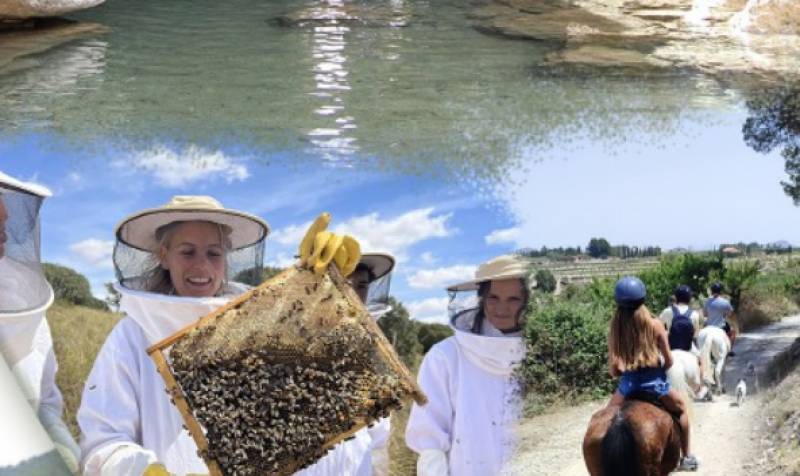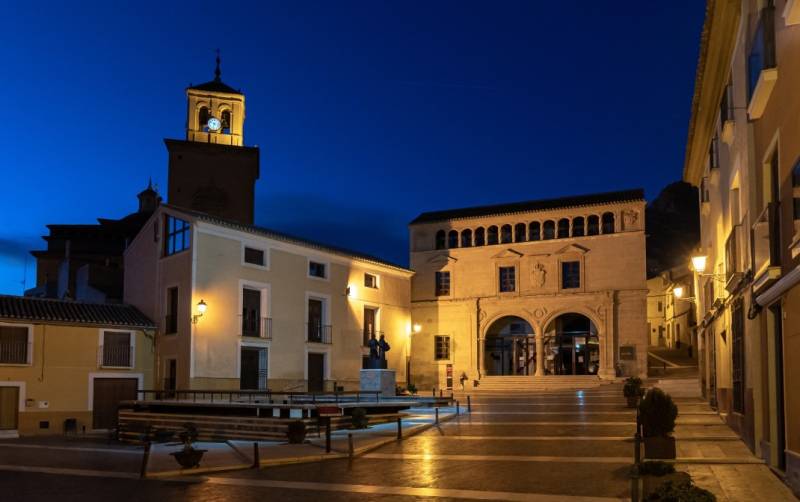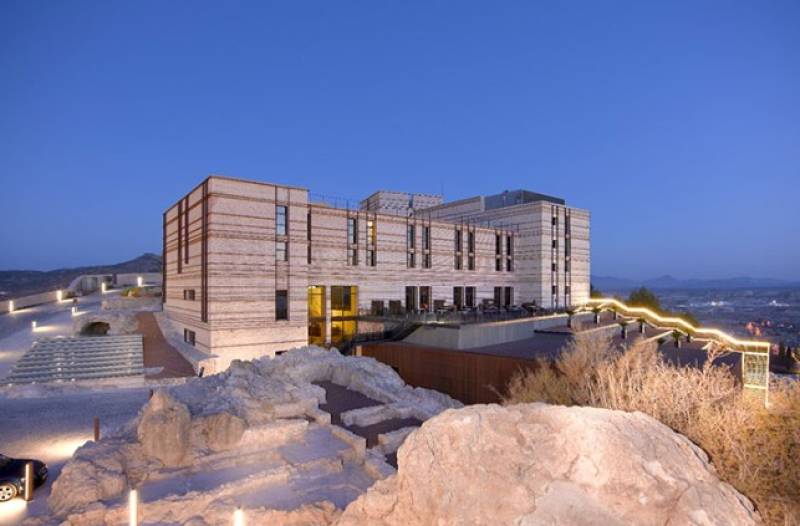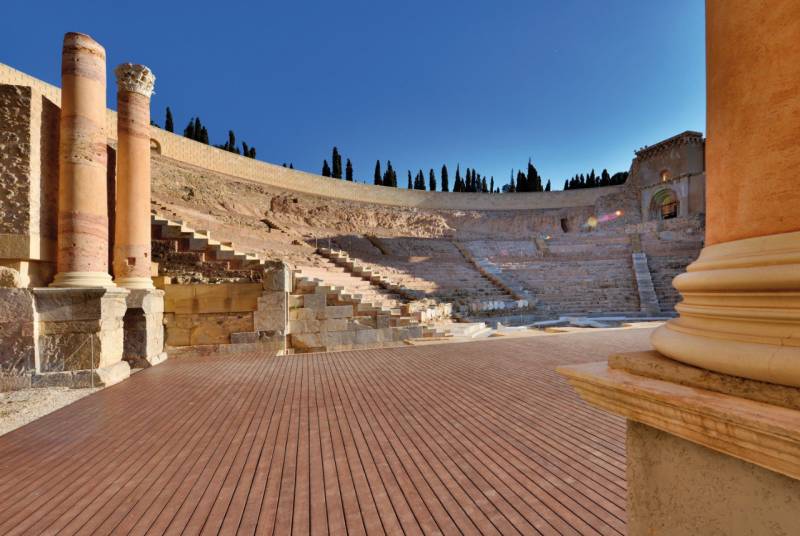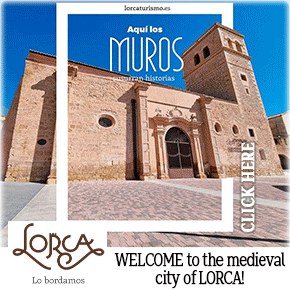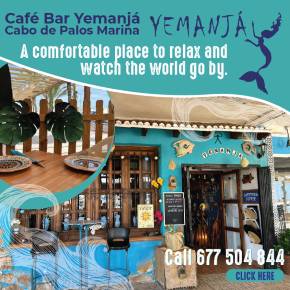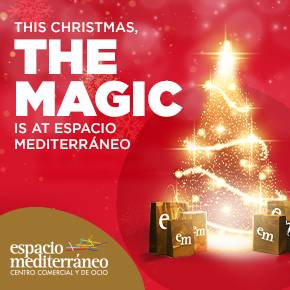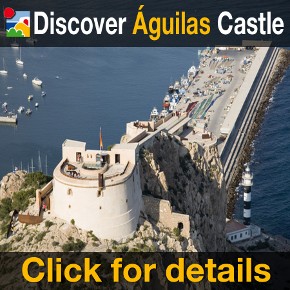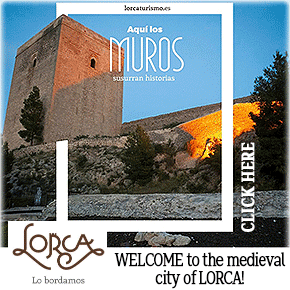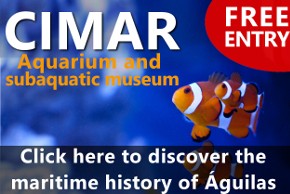- Region
- Águilas
- Alhama de Murcia
- Jumilla
- Lorca
- Los Alcázares
- Mazarrón
- San Javier
-
ALL AREAS & TOWNS
- AREAS
- SOUTH WEST
- MAR MENOR
- MURCIA CITY & CENTRAL
- NORTH & NORTH WEST
- TOWNS
- Abanilla
- Abarán
- Aguilas
- Alamillo
- Alcantarilla
- Aledo
- Alhama de Murcia
- Archena
- Balsicas
- Blanca
- Bolnuevo
- Bullas
- Cañadas del Romero
- Cabo de Palos
- Calasparra
- Camping Bolnuevo
- Campo De Ricote
- Camposol
- Canada De La Lena
- Caravaca de la Cruz
- Cartagena
- Cehegin
- Ceuti
- Cieza
- Condado de Alhama
- Corvera
- Costa Cálida
- Cuevas De Almanzora
- Cuevas de Reyllo
- El Carmoli
- El Mojon
- El Molino (Puerto Lumbreras)
- El Pareton / Cantareros
- El Raso
- El Valle Golf Resort
- Fortuna
- Fuente Alamo
- Hacienda del Alamo Golf Resort
- Hacienda Riquelme Golf Resort
- Isla Plana
- Islas Menores & Mar de Cristal
- Jumilla
- La Azohia
- La Charca
- La Manga Club
- La Manga del Mar Menor
- La Pinilla
- La Puebla
- La Torre
- La Torre Golf Resort
- La Unión
- Las Palas
- Las Ramblas
- Las Ramblas Golf
- Las Torres de Cotillas
- Leiva
- Librilla
- Lo Pagan
- Lo Santiago
- Lorca
- Lorquí
- Los Alcázares
- Los Balcones
- Los Belones
- Los Canovas
- Los Nietos
- Los Perez (Tallante)
- Los Urrutias
- Los Ventorrillos
- Mar De Cristal
- Mar Menor
- Mar Menor Golf Resort
- Mazarrón
- Mazarrón Country Club
- Molina de Segura
- Moratalla
- Mula
- Murcia City
- Murcia Property
- Pareton
- Peraleja Golf Resort
- Perin
- Pilar de la Horadada
- Pinar de Campoverde
- Pinoso
- Playa Honda
- Playa Honda / Playa Paraíso
- Pliego
- Portmán
- Pozo Estrecho
- Puerto de Mazarrón
- Puerto Lumbreras
- Puntas De Calnegre
- Region of Murcia
- Ricote
- Roda Golf Resort
- Roldan
- Roldan and Lo Ferro
- San Javier
- San Pedro del Pinatar
- Santiago de la Ribera
- Sierra Espuña
- Sucina
- Tallante
- Terrazas de la Torre Golf Resort
- Torre Pacheco
- Totana
- What's On Weekly Bulletin
- Yecla


- EDITIONS:
 Spanish News Today
Spanish News Today
 Alicante Today
Alicante Today
 Andalucia Today
Andalucia Today
The best snorkelling sites in the Region of Murcia!
Crystalline Mediterranean waters and spectacular scenery and marine life make for great snorkelling beaches in the Costa Cálida
 Now that the heat of summer has reached the Costa Cálida there is no better way to cool down than with a dip in the sea, and the clear waters of the Mediterranean in this part of Spain offer a myriad of opportunities for fascinating and exciting diving and snorkelling.
Now that the heat of summer has reached the Costa Cálida there is no better way to cool down than with a dip in the sea, and the clear waters of the Mediterranean in this part of Spain offer a myriad of opportunities for fascinating and exciting diving and snorkelling.
While the dive sites in Murcia are among the most popular in Europe the prospect of donning wetsuits and breathing apparatus and dropping tens of metres below the surface is not for everyone. On the other hand, there’s no need to go so far down to disconnect from the heat and noise on the shore, and the varied marine life is just as attractive in shallow waters as in the deep!
Among the most recommended locations for snorkelling in the Costa Cálida the regional tourist board of Murcia highlights the following:
Cabo de Palos
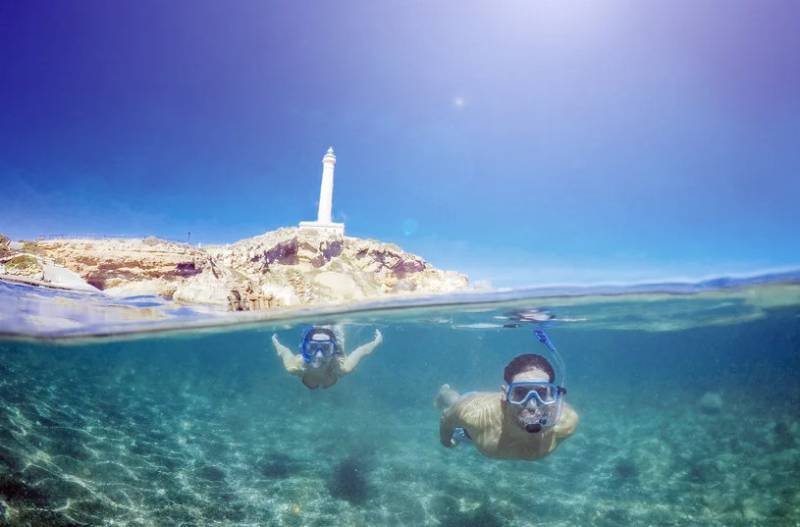 Just below the iconic headland and lighthouse of Cabo de Palos is an array of beaches and coves just waiting to be explored, with nothing more than a snorkel, mask or goggles and a pair of flippers required!
Just below the iconic headland and lighthouse of Cabo de Palos is an array of beaches and coves just waiting to be explored, with nothing more than a snorkel, mask or goggles and a pair of flippers required!
The crystal-clear waters here, where different currents in the Mediterranean meet at the headland, have made Cabo de Palos a renowned dive site attracting visitors from all over the world, and you can choose any spot you in the knowledge that the underwater landscape and wildlife will not disappoint!
Each cove has its own blend of rocks, sand and Posidonia sea grass meadows on the seabed, providing habitats for an extremely wide range of animals, and the only thing likely to tear bathers away from the water is the prospect of the local “caldero” dish in one of the many local seafront restaurants!
One of the most popular areas for underwater adventurers is the marine reserve of Islas Hormigas, and although much of the reserve is for those with breathing apparatus only, there are areas which can be reached from the shore.
Cabo Cope (Águilas)

Águilas is an ideal spot to fully enjoy the attractions of the Mediterranean, not only swimming but also trying your hand at numerous water sports and of course exploring the undersea world.
The coastline of Águilas boasts a huge variety of beaches, from the unspoilt and un-built-up shore in the Marina de Cope area to the huge swathes of golden sand in the town centre, but for snorkelling one of the most popular destinations is the water around the imposing headland of Cabo Cope. From the land, from the air and from the sea this iconic geographical feature is an unmissable sight, and the marine wildlife around it make it a must for those exploring the waters of the Costa Cálida!
Calblanque
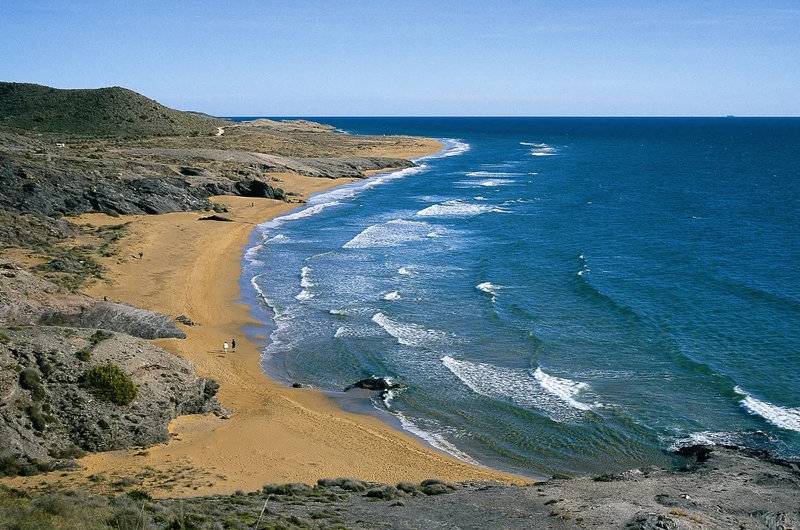 Calblanque is home to one of Murcia's regional parks, areas in which the natural environment is protected, and contains many unspoilt beaches and coves. Within the limits of the park all development is banned the number of visitors at any given time is limited, and this makes it an excellent place to enjoy a spot of snorkelling.
Calblanque is home to one of Murcia's regional parks, areas in which the natural environment is protected, and contains many unspoilt beaches and coves. Within the limits of the park all development is banned the number of visitors at any given time is limited, and this makes it an excellent place to enjoy a spot of snorkelling.
The coast here alternates between steep cliffs, idyllic little coves (including Cala Arturo, Cala Magre and Cala de Los Dentones) and the long stretches of golden sand at Playa Larga, Playa Parreño, Playa Negrete and Playa de Las Cañas.
Just one warning: in summer it’s best to arrive fairly early in the morning, as the limited parking spaces set back from the shore soon fill up!
Cabo Tiñoso
Another of the headlands which punctuate the coastline of Murcia, Cabo Tiñoso is also home to a marine reserve which has helped to maintain the pristine condition of the seabed and the water, which locals confidently claim is the clearest in the Mediterranean.
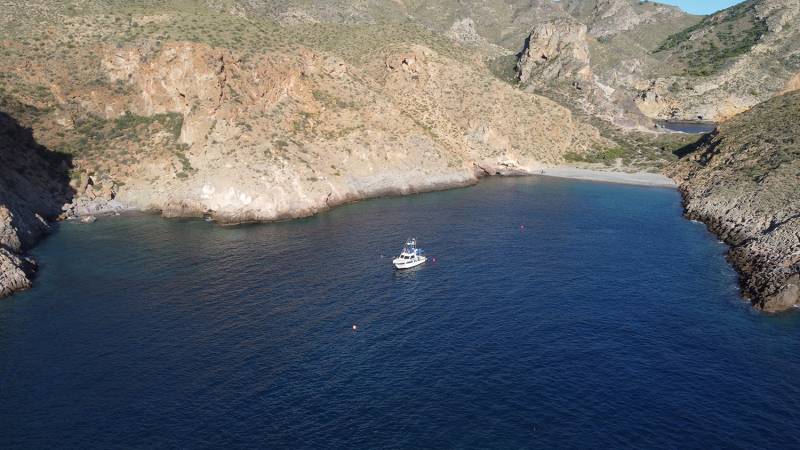 Due to the mountainous terrain some of the coves around Cabo Tiñoso are not easy to reach, but one of the most popular is Cala Cerrada. This is accessed either by boat or by walking for half an hour from the road which leads up to the Castillitos gun battery, and the reward for the snorkellers making the effort is an unbeatable setting, at the same time tranquil and spectacular, as well as a wide variety of marine life.
Due to the mountainous terrain some of the coves around Cabo Tiñoso are not easy to reach, but one of the most popular is Cala Cerrada. This is accessed either by boat or by walking for half an hour from the road which leads up to the Castillitos gun battery, and the reward for the snorkellers making the effort is an unbeatable setting, at the same time tranquil and spectacular, as well as a wide variety of marine life.
Many visitors also include a hike in the mountains of Sierra de la Muela while in the area, and then enjoy a perfect spot for a picnic lunch after an hour or two exploring this hidden corner of the Mediterranean!
Isla Plana
Within a few kilometres to the east of Cabo Tiñoso are the picturesque villages of La Azohía and Isla Plana, where the water is as crystal-clear as around the headland itself but access is considerably easier!
Isla Plana is an especially good place to take the children snorkelling, as they don't need to be strong swimmers to make their way all around the little island which gives the village its name. Octopus and crabs can be seen in the rocks along the shore of the island, and the water is shallow enough for them to be safe as long as they don’t stray too far!
The Mar Menor – Lo Pagán, La Puntica and Playa de los Alemanes
If Isla Plana is a great spot for snorkelling with the kids, then the Mar Menor is even better! Warmer, calmer water makes it perfect for youngsters and beginners, and although the seabed is generally sandy there are also areas with thick underwater vegetation which is home to small creatures like crabs, shrimps, sea urchins and even shoals of baby mullet!
Seahorse alert – use your love of snorkelling to protect the marine environment!
 Snorkelling is a fantastic way to development an understanding and appreciation of the marine environment close to the coast and just might spark your interest in conserving this environment. In the Mar Menor, the Asociación Hippocampus has been campaigning for many years to preserve the dwindling seahorse (Hippocampus guttulatus) population of the lagoon, and this is still necessary because the species is especially sensitive to changes in the marine ecosystem.
Snorkelling is a fantastic way to development an understanding and appreciation of the marine environment close to the coast and just might spark your interest in conserving this environment. In the Mar Menor, the Asociación Hippocampus has been campaigning for many years to preserve the dwindling seahorse (Hippocampus guttulatus) population of the lagoon, and this is still necessary because the species is especially sensitive to changes in the marine ecosystem.
Once you have a little snorkelling experience under your belt, you can join in activities such as water quality sampling and seabed cleaning as a volunteer!
Recommendations for safe and responsible snorkelling
Before you don your mask and flippers, it’s important to bear in mind the following advice:
- Choose the right spot – a calm area without too many waves and hidden currents. Check whether there are any environmental protection rules in case or whether snorkelling is limited by regulations.
- Avoid stirring up the sand on the seabed, especially in areas with underwater vegetation.
- Don’t touch or remove underwater flora and fauna – just observe it without touching!
- Don’t leave rubbish in the water.
- Use bio-gradable sun cream to avoid contaminating the water (this is easy to find in sports shops and major supermarkets).
- Don’t go out alone – take company whenever possible, and make sure you establish a clear visual marker on the shore before straying from your starting point.
- Check water conditions before you start and if you have any doubts ask the lifeguards service.
The Region of Murcia offers all kinds of excellent snorkelling venues and a range of sights to see: caves, rocks, sand, sea grass and even seahorses. And if we combine the activity with a commitment to marine conservation, like the activities of the Asociación Hippocampus, the experience is enhanced still further, so enjoy, observe and help to protect the rich diversity of the sea.
For further information and suggestions, download the regional tourist board’s guide for diving in Murcia!
Source: ITREM
Sign up for the Spanish News Today Editors Roundup Weekly Bulletin and get an email with all the week’s news straight to your inbox
Special offer: Subscribe now for 25% off (36.95 euros for 48 Bulletins)
OR
you can sign up to our FREE weekly roundup!
Read some of our recent bulletins:
Discount Special Offer subscription:
36.95€ for 48 Editor’s Weekly News Roundup bulletins!
Please CLICK THE BUTTON to subscribe.
(List price 3 months 12 Bulletins)
Read more stories from around Spain:









